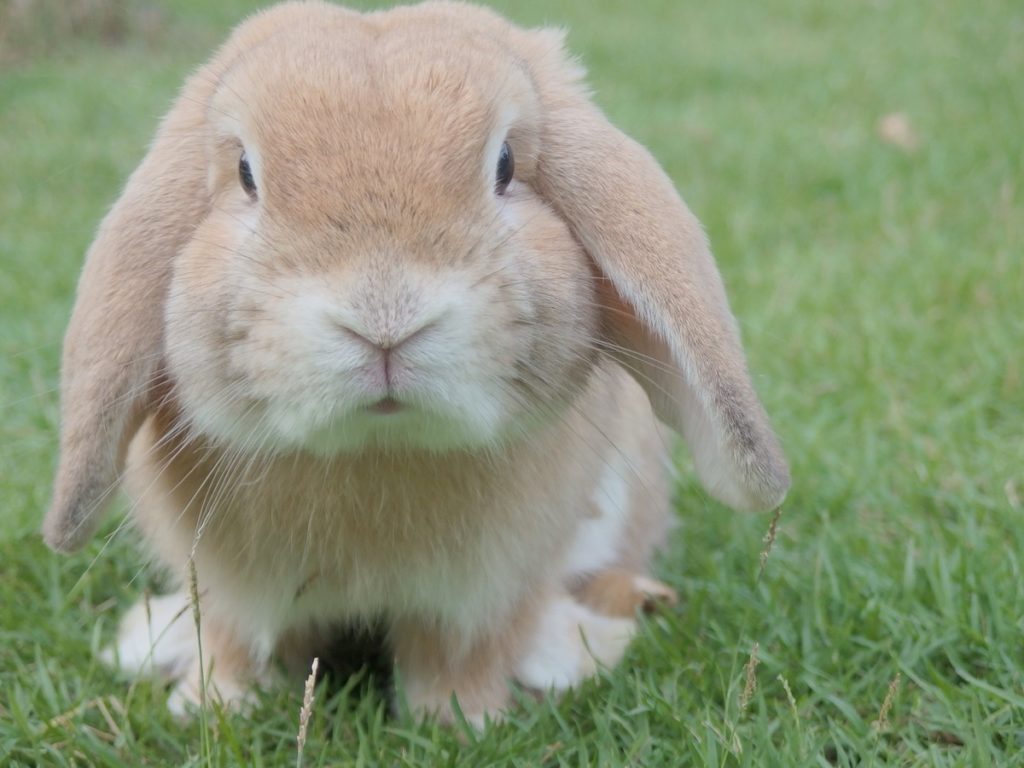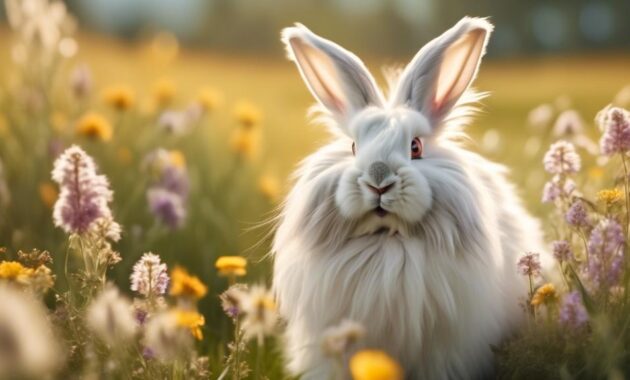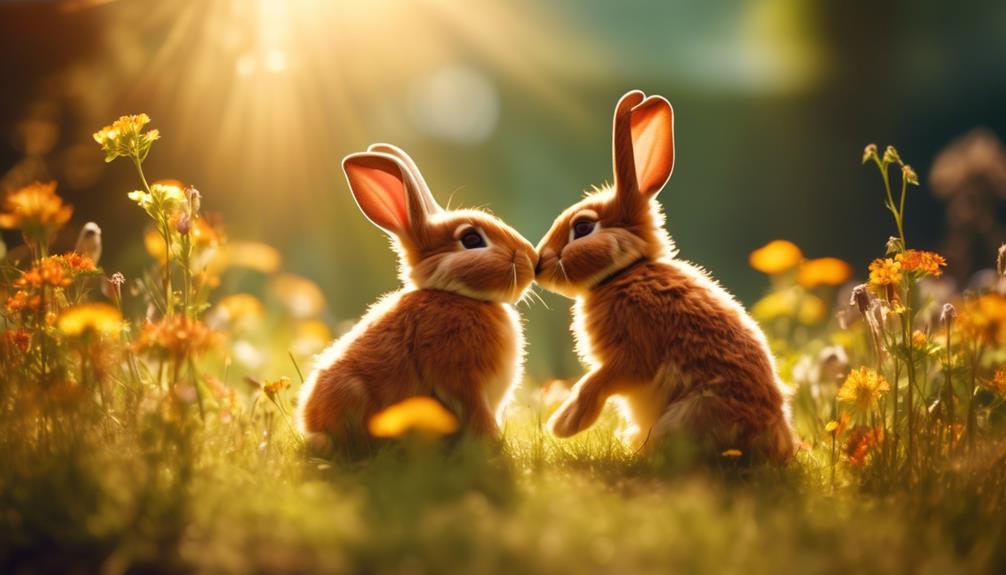
Step into the enchanting world of Cinnamon Rabbits.
You will be whisked away on a journey filled with wonder and fascination.
Like a hidden treasure waiting to be discovered, these captivating creatures hold secrets that will leave you longing for more.
But what makes them so enchanting?
What sets them apart from other rabbit breeds?
Prepare to be captivated as we unravel the mysteries and unveil the allure of these extraordinary animals.
Key Takeaways
- Cinnamon rabbits are medium-sized and weigh between 9-11 pounds, making them a suitable pet for families with or without children.
- They have a docile and friendly temperament, making them an excellent choice for first-time rabbit owners.
- Cinnamon rabbits have a stunning coat with ground cinnamon-colored fur and smoky gray/black accents on their nose, ears, belly, and paws.
- Their care requirements are relatively easy, including regular grooming, appropriate bedding, and a diet consisting of hay and fresh vegetables.
Cinnamon Rabbit Description and Characteristics
Cinnamon rabbits are medium-sized rabbits known for their stunning ground cinnamon-colored fur and docile temperament. They typically weigh between 9 and 11 pounds and have a lifespan of 5 to 10 years.
With their commercial body shape, they’re well-suited for families, whether they’ve children or not, and are great for first-time owners. These rabbits have a docile, calm, curious, and friendly temperament, making them a joy to have as pets. Comparable breeds include the New Zealand Rabbit and the Californian Rabbit.
Cinnamon rabbits originated in the 1960s, starting with a Chinchilla Doe and a New Zealand buck mating. Over time, they were further developed through crossbreeding with Checkered Giant and Californian rabbits, eventually becoming their own distinct breed.
Cinnamon Rabbit Breed History and Origin
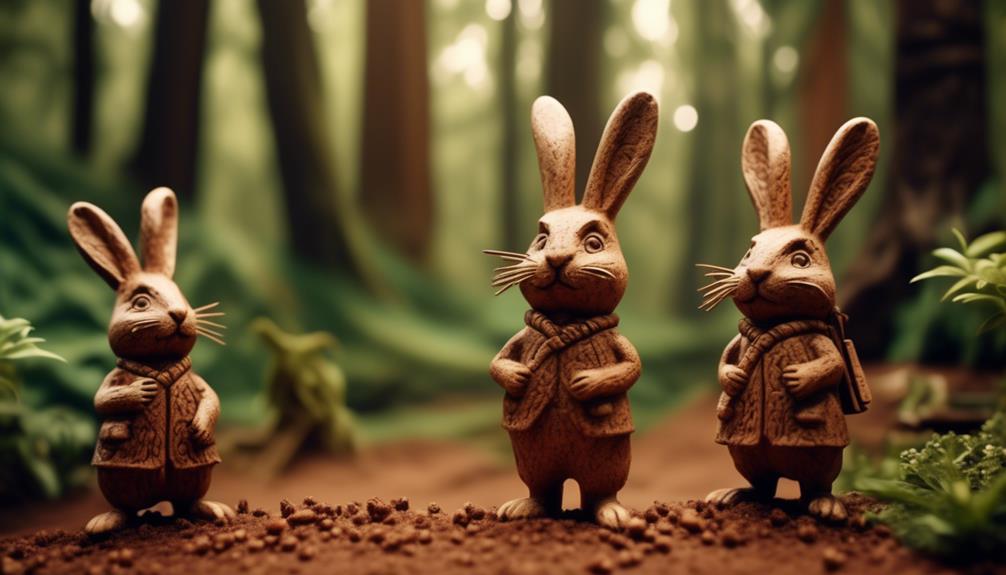
The fascinating history and origin of the Cinnamon Rabbit breed can be traced back to the 1960s when it began with a Chinchilla Doe and a New Zealand buck mating. From there, the breed went through a series of crossbreeding experiments, including mixes with Checkered Giant and Californian rabbits.
However, it was J. Cyrol Lowett who suggested solely breeding Cinnamon rabbits, leading to the development of the breed as we know it today. The Cinnamon Rabbit breed emerged as its own separate entity, with its distinct characteristics and appearance.
This breed’s unique lineage and intentional breeding efforts have resulted in a stunning rabbit with a ground cinnamon-colored fur, proportional heads, and vertical ears.
Cinnamon Rabbit Appearance
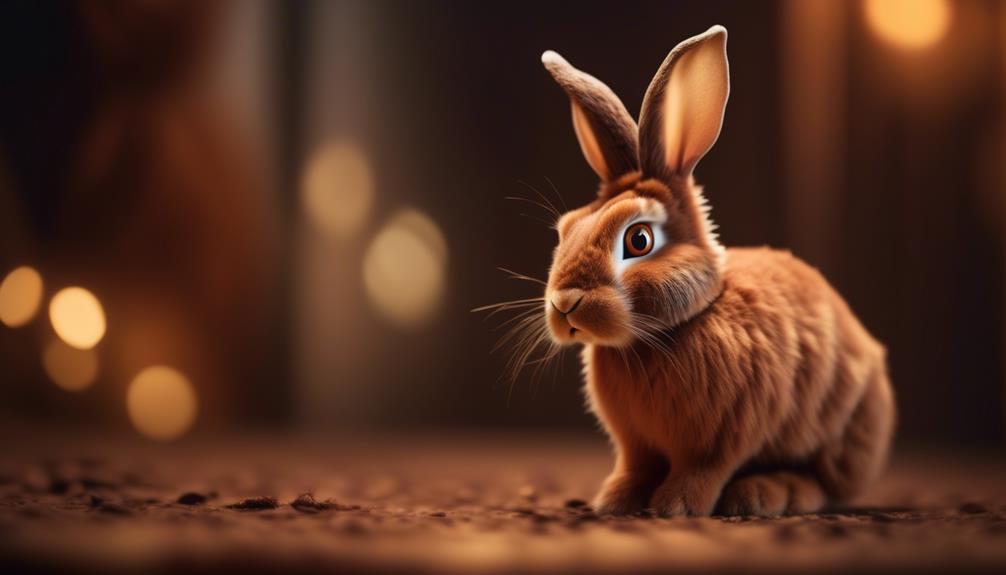
With their stunning coat and proportional features, Cinnamon Rabbits exhibit an appearance that’s sure to catch your eye. These medium-sized rabbits weigh no more than 9 pounds and have a show-worthy look.
Their most striking feature is their coat, which is a beautiful ground cinnamon color that resembles the spice it’s named after. Along with their cinnamon fur, Cinnamon Rabbits also have smoky gray shading around their ears, snout, and paws.
Their heads are proportional to their bodies, and they’ve vertical ears that add to their overall charm. Their unique coloring and well-proportioned features make Cinnamon Rabbits a truly enchanting sight to behold.
Cinnamon Rabbit Coat and Colors
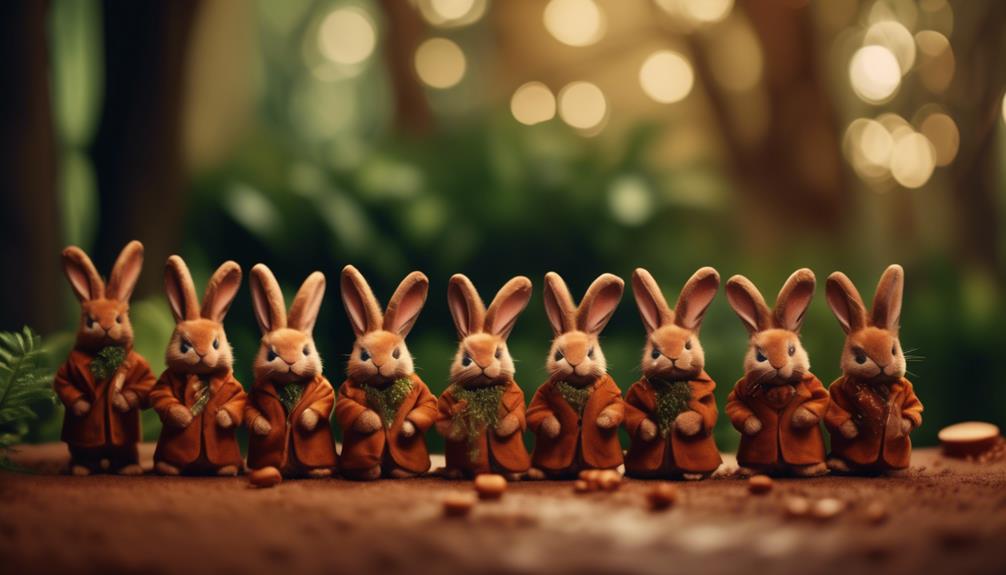
To fully appreciate the unique beauty of Cinnamon Rabbits, you must observe their exquisite coat and colors.
Here are four things you need to know about their coat and colors:
- Short and relatively easy to maintain coat: Cinnamon Rabbits have a short coat that doesn’t require extensive grooming. Regular brushing with a slicker brush once a week or every two weeks will keep their fur looking neat and clean.
- Shedding season requires increased grooming: Like most rabbits, Cinnamon Rabbits go through shedding seasons where they lose their old fur to make way for new growth. During these times, you may need to increase the frequency of grooming to prevent their fur from matting.
- Light brown color resembling ground cinnamon: The most striking feature of Cinnamon Rabbits is their coat color. It’s a beautiful light brown shade that closely resembles the color of ground cinnamon, giving them their name.
- Smoky gray shading around ears, snout, and paws: Along with their cinnamon-colored fur, Cinnamon Rabbits also have smoky gray shading around their ears, snout, and paws. This adds depth and contrast to their overall appearance, making them even more captivating to look at.
Cinnamon Rabbit Care Requirements
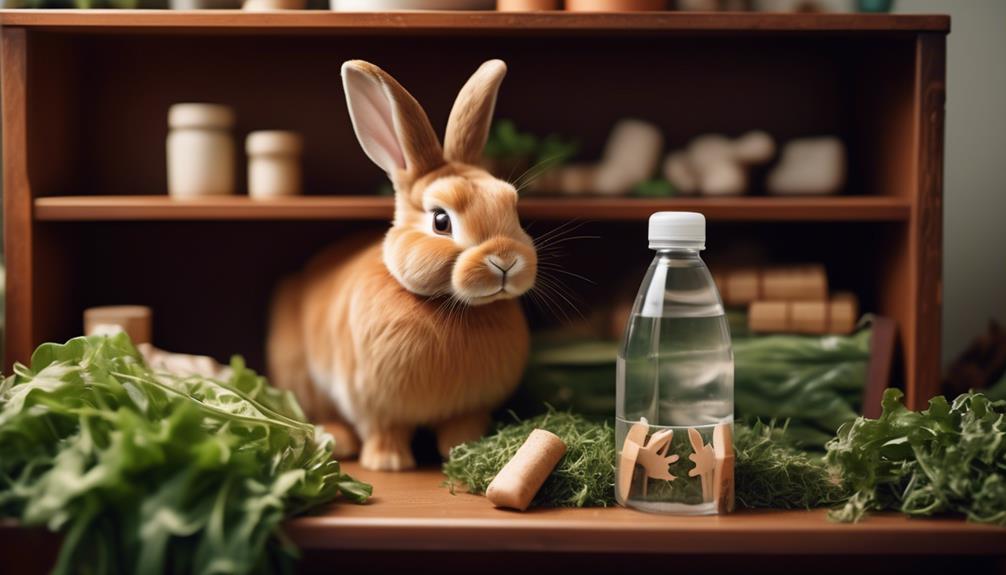
Taking care of a Cinnamon Rabbit is relatively easy and requires a few essential requirements.
To keep your rabbit healthy and happy, it’s important to provide proper grooming and bedding.
Their short coat is relatively easy to maintain, but during shedding season, you should increase grooming to prevent matting.
When it comes to bedding, use wood pellets or aspen bedding, as pine or cedar can be harmful to their respiratory system.
Cinnamon Rabbits are herbivores, so their diet should consist of hay and fresh vegetables.
It’s important to limit fruits with high sugar content and always provide fresh water.
Cinnamon Rabbit Diet and Feeding
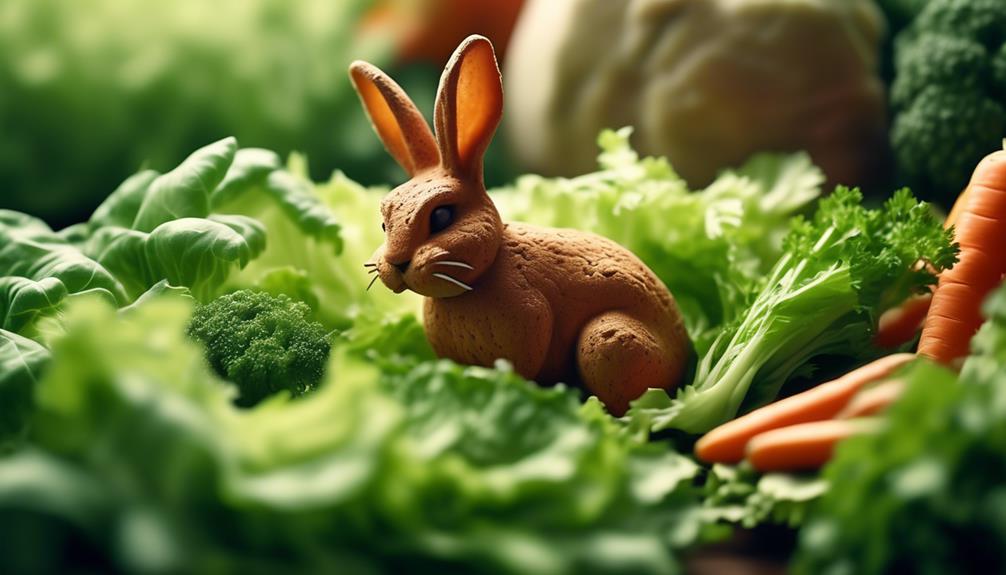
For optimal health and nutrition, feeding your Cinnamon Rabbit a balanced diet is essential. Here are four key points to keep in mind when it comes to the diet and feeding of your Cinnamon Rabbit:
- Hay: Make sure to provide unlimited access to high-quality hay, such as timothy or orchard grass. Hay is an essential part of their diet and helps maintain healthy digestion.
- Fresh Vegetables: Offer a variety of fresh vegetables daily, including leafy greens like romaine lettuce, spinach, and kale. Carrots, bell peppers, and broccoli can also be included in small amounts.
- Pellets: Choose high-quality rabbit pellets that are specifically formulated for adult rabbits. These pellets should make up a small portion of their diet and should be fed in moderation.
- Limited Fruits: While fruits can be a tasty treat, they should be given sparingly due to their high sugar content. Stick to small amounts of fruits like apples, strawberries, or blueberries as an occasional treat.
Cinnamon Rabbit Housing and Environment
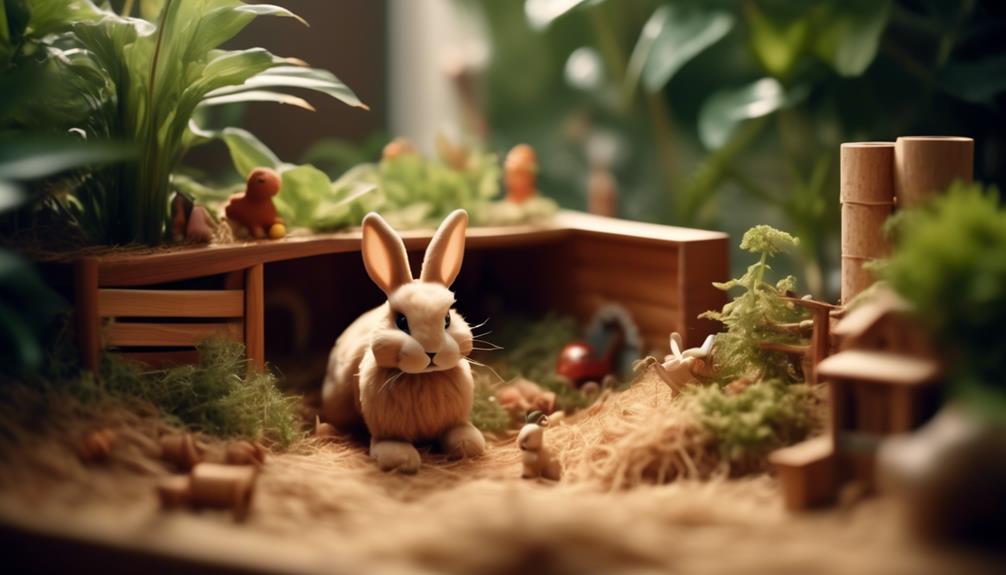
Creating a suitable housing and environment for your Cinnamon Rabbit is crucial for their well-being and happiness. These rabbits thrive in spacious and well-ventilated enclosures that provide them with enough room to hop and explore. A recommended minimum cage size is 24 inches by 36 inches, but the more space, the better. It is important to provide plenty of hiding spots and toys to keep them mentally stimulated. In addition to a suitable cage, a rabbit-safe environment is essential. Avoid exposing them to extreme temperatures, direct sunlight, or drafts. Be mindful of potential hazards such as electrical cords, toxic plants, and small objects they could chew on. By creating a comfortable and safe habitat, you can ensure that your Cinnamon Rabbit leads a happy and healthy life.
| Housing Tips | Environment Tips |
|---|---|
| Spacious and well-ventilated | Avoid extreme temperatures |
| Provide hiding spots and toys | Protect from direct sunlight and drafts |
| Minimum size: 24″ x 36″ | Eliminate potential hazards |
Cinnamon Rabbit Health and Common Issues
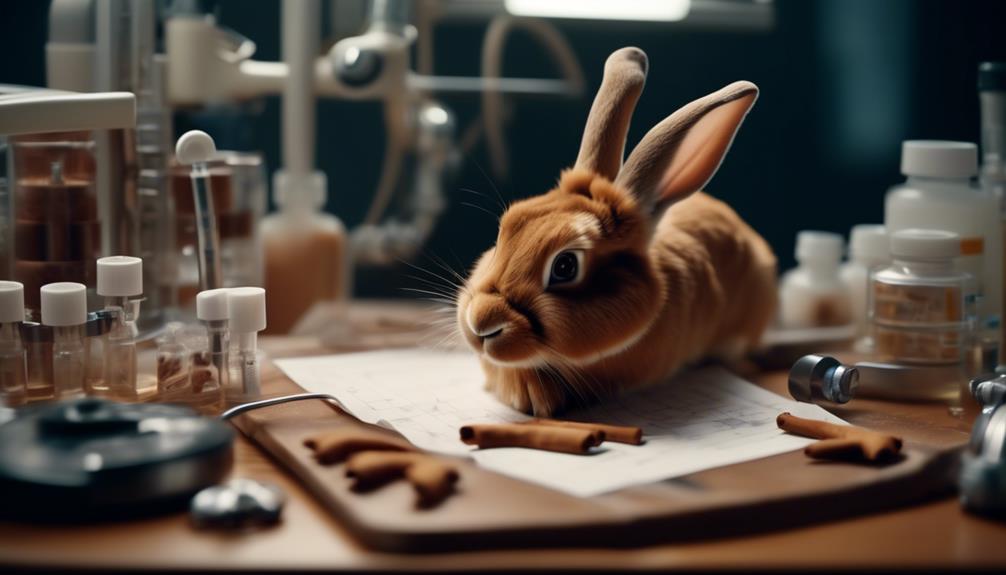
Cinnamon Rabbit health and common issues should be closely monitored to ensure the well-being of these adorable and curious creatures. Here are four important aspects to consider:
- Regular Veterinary Check-ups: Schedule routine visits with a rabbit-savvy veterinarian to monitor your Cinnamon Rabbit’s overall health and detect any potential issues early on.
- Dental Care: Rabbits have continuously growing teeth, so providing them with appropriate chew toys and a diet high in fiber is essential to prevent dental problems such as overgrown teeth or dental abscesses.
- Gastrointestinal Health: Cinnamon Rabbits are prone to digestive issues, such as bloating and gastrointestinal stasis. Ensure they’ve a high-fiber diet, access to fresh water, and plenty of exercise to maintain a healthy digestive system.
- Parasite Prevention: Protect your Cinnamon Rabbit from external and internal parasites by regularly checking for signs of fleas, ticks, mites, and worms. Consult your veterinarian for safe and effective prevention methods.
Cinnamon Rabbit Temperament and Behavior
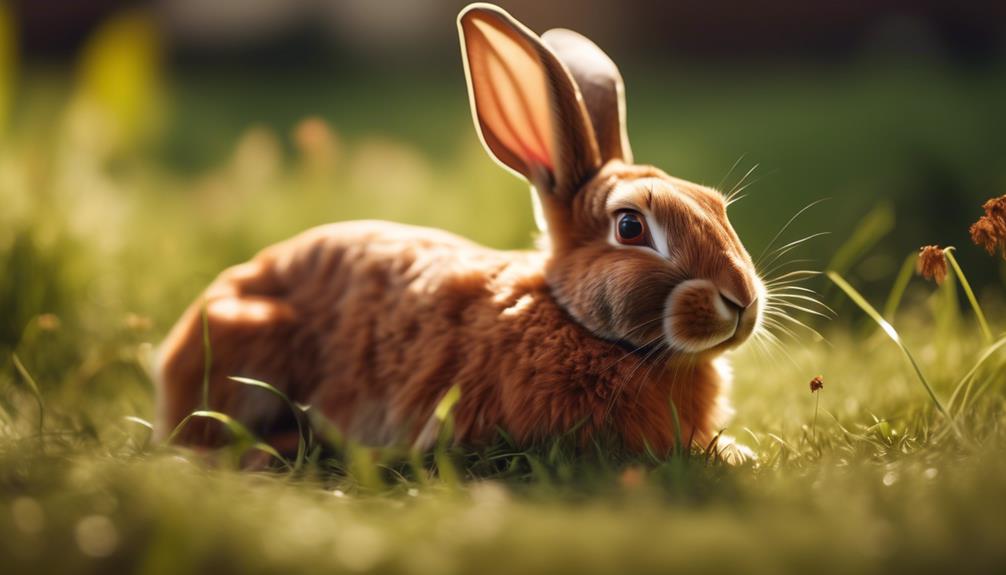
When it comes to temperament and behavior, the Cinnamon Rabbit is known for its docile and friendly nature. These rabbits are calm and enjoy the company of their human companions. They’re curious and love to explore their surroundings.
Cinnamon Rabbits are known to be social animals and get along well with other rabbits, making them a great choice for families with multiple pets. They’re also good with children, as they’re patient and tolerate handling. Cinnamon Rabbits aren’t known to be aggressive and rarely exhibit any signs of aggression.
However, it’s important to note that individual rabbit personalities can vary, so it’s always recommended to spend time getting to know your rabbit and providing proper socialization to ensure a happy and well-adjusted pet.
Cinnamon Rabbit Training and Socialization
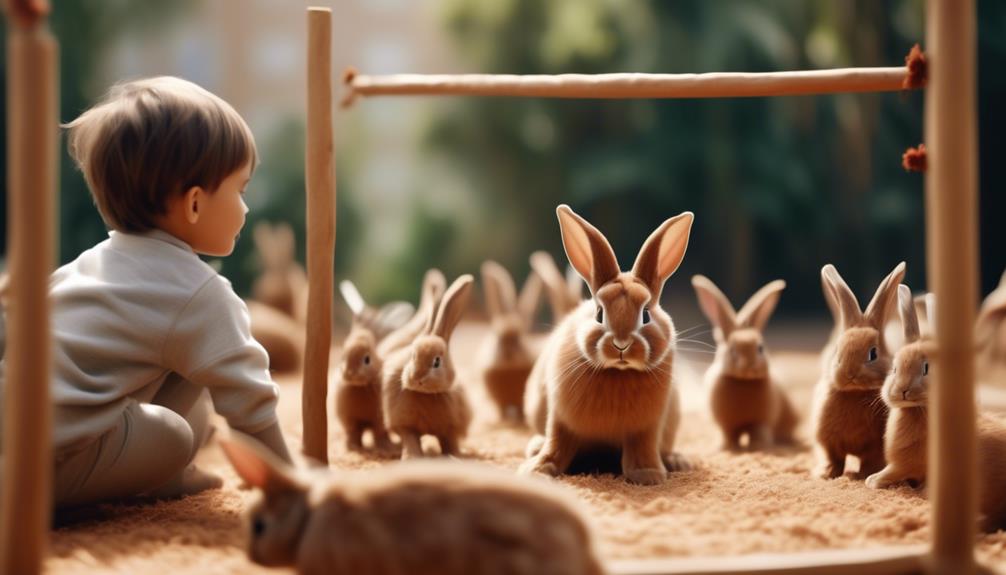
To ensure a well-behaved and socially adjusted Cinnamon Rabbit, it’s important to focus on training and socialization from an early age. Here are four key aspects to consider:
- Start early: Begin training and socializing your Cinnamon Rabbit as soon as you bring them home. This will help them become accustomed to human interaction and establish a bond with you.
- Positive reinforcement: Use rewards such as treats and praise to encourage good behavior. Cinnamon Rabbits respond well to positive reinforcement and will be more likely to repeat desired actions.
- Basic commands: Teach your Cinnamon Rabbit simple commands like ‘come,’ ‘stay,’ and ‘no.’ This won’t only make daily interactions easier but also ensure their safety in different situations.
- Exposure to different environments: Introduce your Cinnamon Rabbit to various environments, sounds, and experiences. This will help them become more confident, adaptable, and well-rounded companions.
Cinnamon Rabbit Exercise and Enrichment
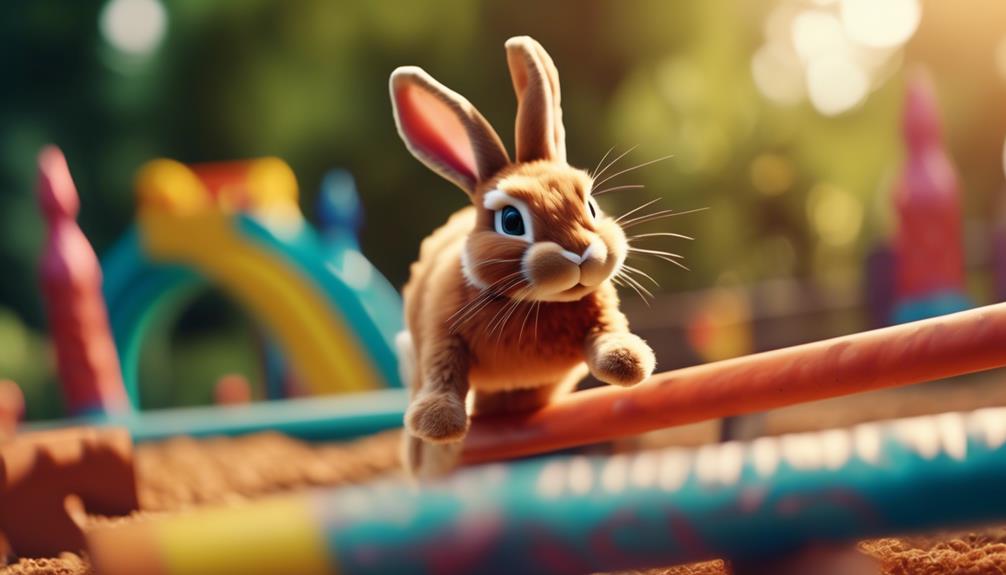
For optimal health and well-being, it is important to provide regular exercise and enrichment activities for your Cinnamon Rabbit. These activities not only keep your rabbit physically fit, but also mentally stimulated. A bored rabbit can become destructive or exhibit behavioral problems, so it’s crucial to provide them with plenty of opportunities for exercise and mental engagement.
Here are some exercise and enrichment ideas for your Cinnamon Rabbit:
| Exercise Activities | Enrichment Activities |
|---|---|
| Provide a large, safe area for your rabbit to hop and run around freely | Hide treats around their enclosure to encourage foraging behavior |
| Set up an obstacle course with tunnels, ramps, and platforms | Offer a variety of toys, such as chew toys and puzzle toys, to keep them entertained |
| Take your rabbit for supervised outdoor playtime in a secure, rabbit-proofed area | Rotate their toys regularly to keep them engaged and prevent boredom |
Cinnamon Rabbit Breeding and Reproduction
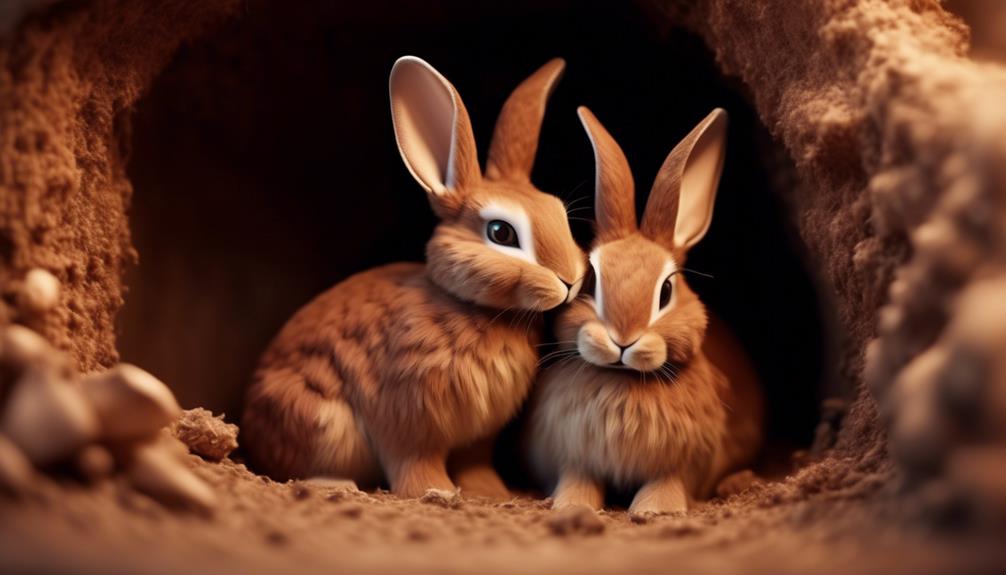
Breeding and reproducing Cinnamon Rabbits involves careful selection of compatible mates. To ensure successful breeding and healthy offspring, consider the following:
- Age and Health: Choose rabbits that are at least six months old and in good health. Conduct a thorough health check-up before breeding.
- Genetics and Pedigree: Select rabbits with desirable traits and genetic diversity. Check their pedigrees to avoid inbreeding and genetic disorders.
- Pairing Compatibility: Consider the rabbits’ temperaments and personalities. Choose mates that exhibit compatible behaviors to reduce stress and aggression during mating.
- Breeding Environment: Provide a spacious and comfortable breeding area. Ensure privacy, proper temperature, and cleanliness to encourage successful mating.
Cinnamon Rabbit Tips for First-Time Owners
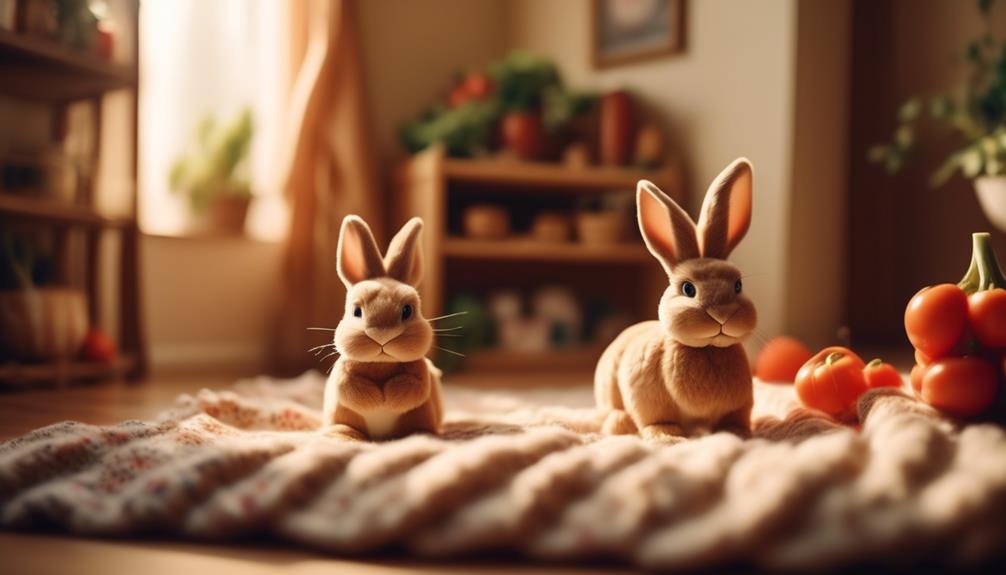
If you’re a first-time owner of a Cinnamon Rabbit, here are some helpful tips to ensure a happy and successful ownership experience.
First, provide your rabbit with a spacious and comfortable enclosure, as they need plenty of room to hop and play. Make sure to use wood pellets or aspen bedding, avoiding pine or cedar, to keep their living area clean and safe.
Additionally, Cinnamon Rabbits are herbivores, so their diet should consist of high-quality hay and fresh vegetables. Limit fruits with high sugar content and always provide fresh water.
Grooming is relatively easy, requiring weekly or biweekly brushing with a slicker brush, and increased grooming during shedding season.
Frequently Asked Questions
Are Cinnamon Rabbits Suitable for Apartment Living?
Yes, cinnamon rabbits are suitable for apartment living. They are medium-sized and relatively easy to care for. With their docile and friendly temperament, they can adapt well to living in an apartment with you.
How Often Do Cinnamon Rabbits Need to Be Groomed?
Cinnamon rabbits need to be groomed weekly or biweekly, with increased grooming during shedding season. Use a slicker brush to maintain their short coat. Keep them looking their best and feeling comfortable!
Can Cinnamon Rabbits Be Litter Trained?
Yes, cinnamon rabbits can be litter trained. With a consistent routine and positive reinforcement, you can teach them to use a litter box. Provide them with a suitable litter box and reward them for using it correctly.
What Kind of Toys and Enrichment Activities Are Best for Cinnamon Rabbits?
To keep your cinnamon rabbit entertained, provide toys like chew sticks, tunnels, and puzzle feeders. Enrichment activities can include obstacle courses, hiding treats, and supervised outdoor playtime. Keep them mentally stimulated for a happy bunny!
Do Cinnamon Rabbits Have Any Specific Health Concerns or Common Issues to Be Aware Of?
Cinnamon rabbits don’t have specific health concerns, but it’s important to watch for common issues like dental problems and obesity. Regular vet check-ups, a balanced diet, and plenty of exercise will keep your cinnamon rabbit happy and healthy.
What Makes Swiss Fox Rabbits Similar to Cinnamon Rabbits?
Swiss Fox Rabbits share many similarities with Cinnamon Rabbits, both belonging to the enchanting Swiss Fox Rabbits world. They both have similar body shapes, ear lengths, and fur colors. These breeds are known for their friendly temperaments and make great pets for rabbit enthusiasts.
Conclusion
So there you have it, the enchanting world of Cinnamon Rabbits awaits you! With their stunning appearance and friendly temperament, these rabbits make the perfect addition to any household.
Whether you’re a first-time owner or have a family with children, Cinnamon Rabbits are sure to bring joy and wonder to your life.
Don’t miss out on the opportunity to discover the captivating beauty and delightful characteristics of this unique breed. Start your journey with Cinnamon Rabbits today!

